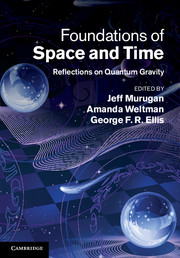Book contents
- Frontmatter
- Contents
- List of contributors
- 1 The problem with quantum gravity
- 2 A dialogue on the nature of gravity
- 3 Effective theories and modifications of gravity
- 4 The small-scale structure of spacetime
- 5 Ultraviolet divergences in supersymmetric theories
- 6 Cosmological quantum billiards
- 7 Progress in RNS string theory and pure spinors
- 8 Recent trends in superstring phenomenology
- 9 Emergent spacetime
- 10 Loop quantum gravity
- 11 Loop quantum gravity and cosmology
- 12 The microscopic dynamics of quantum space as a group field theory
- 13 Causal dynamical triangulations and the quest for quantum gravity
- 14 Proper time is stochastic time in 2D quantum gravity
- 15 Logic is to the quantum as geometry is to gravity
- 16 Causal sets: discreteness without symmetry breaking
- 17 The Big Bang, quantum gravity and black-hole information loss
- 18 Conversations in string theory
- Index
- References
13 - Causal dynamical triangulations and the quest for quantum gravity
Published online by Cambridge University Press: 05 August 2012
- Frontmatter
- Contents
- List of contributors
- 1 The problem with quantum gravity
- 2 A dialogue on the nature of gravity
- 3 Effective theories and modifications of gravity
- 4 The small-scale structure of spacetime
- 5 Ultraviolet divergences in supersymmetric theories
- 6 Cosmological quantum billiards
- 7 Progress in RNS string theory and pure spinors
- 8 Recent trends in superstring phenomenology
- 9 Emergent spacetime
- 10 Loop quantum gravity
- 11 Loop quantum gravity and cosmology
- 12 The microscopic dynamics of quantum space as a group field theory
- 13 Causal dynamical triangulations and the quest for quantum gravity
- 14 Proper time is stochastic time in 2D quantum gravity
- 15 Logic is to the quantum as geometry is to gravity
- 16 Causal sets: discreteness without symmetry breaking
- 17 The Big Bang, quantum gravity and black-hole information loss
- 18 Conversations in string theory
- Index
- References
Summary
Quantum gravity by causal dynamical triangulation has over the last few years emerged as a serious contender for a nonperturbative description of the theory. It is a nonperturbative implementation of the sum-overhistories, which relies on few ingredients and initial assumptions, has few free parameters and – crucially – is amenable to numerical simulations. It is the only approach to have demonstrated that a classical universe can be generated dynamically from Planckian quantum fluctuations. At the same time, it allows for the explicit evaluation of expectation values of invariants characterizing the highly nonclassical, short-distance behaviour of spacetime. As an added bonus, we have learned important lessons on which aspects of spacetime need to be fixed a priori as part of the background structure and which can be expected to emerge dynamically.
Quantum gravity – taking a conservative stance
Many fundamental questions about the nature of space, time and gravitational interactions are not answered by the classical theory of general relativity, but lie in the realm of the still-searched-for theory of quantum gravity: What is the quantum theory underlying general relativity, and what does it say about the quantum origins of space, time and our universe? What is the microstructure of spacetime at the shortest scale usually considered, the Planck scale lPl = 10-35m, and what are the relevant degrees of freedom determining the dynamics there?
- Type
- Chapter
- Information
- Foundations of Space and TimeReflections on Quantum Gravity, pp. 321 - 337Publisher: Cambridge University PressPrint publication year: 2012
References
- 9
- Cited by



